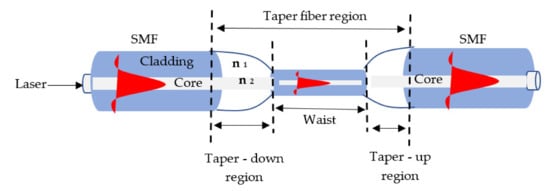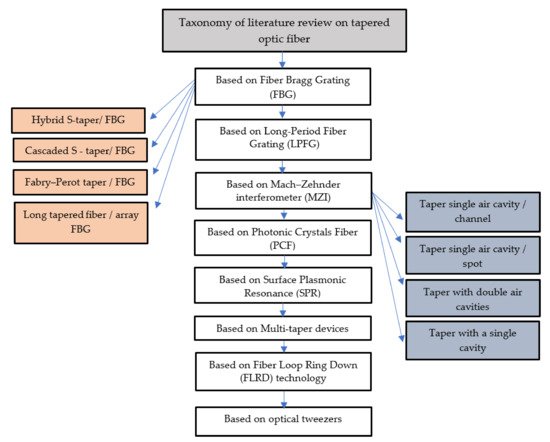In the 1960s, many studies have attempted to develop optical fiber in different fields such as communication, medicine, the environment, and many others. Essentially, optical sensing originated from fiber communication. The employment of lasers with optical fiber enables accurate and sensitive detection compared with other techniques. This method has the advantage of notable features such as interference resistance, adaptability, real-time parameter monitoring, and small size
[19][20][21][22][23][19,20,21,22,23]. Many optical fiber structures use lasers such as FBG, fiber-optic interferometer, optical fiber MZI, buffer structure, Fabry–Perot, directional couplers, and optical fiber waveguides to a biosensor
[24][25][26][27][28][24,25,26,27,28]. Tapered fiber production has been shown to employ several processes, including laser ablation, electron beam lithography, vapor–liquid–solid operations, and fiber pulling. Among these processes, flame heating is one of the most adaptable to produce tapered fibers with good physical properties
[29][30][31][29,30,31]. Optical sensors can detect changes in optics properties such as refractive index (RI), absorption, reflection, and fluorescence related to the physical parameters of the investigated environment such as pressure, strain, temperature, and chemical composition. In contrast, it is simple to create optical sensors by guiding light to and collecting light from the measuring location, a process known as extrinsic sensing
[32], or by using the fiber itself as the transducer, a technique known as intrinsic sensing
[33]. Assessment approaches based on optical fibers received considerable attention in various analytical fields, including chemical and biological sensing, environmental and structural health monitoring, and medical diagnostics. Their vast range of designs and methods enable optical fibers to construct sensitive and selective sensors for real-world circumstances
[34][35][36][34,35,36]. The tapered fiber technique is one of the most widely used in the production of optical sensor components. The tapered fiber technique uses the evanescent wave (EW) tapered-propagating mode to determine RI or chemical composition properties
[37]. Recently, tapered optical fibers have been used to create sensors including polarizers, sub-micron wire, light amplification, and near-field microscopy
[38][39][40][41][42][38,39,40,41,42]. As shown in the literature, the shape of the tapered fiber is critical to its sensor function, with lower diameter taper waists giving increased sensitivity
[43][44][43,44]. Additionally, tapered fiber optics may be used as light probes to evaluate characteristics of interest with spatial precision on the scale of micrometers, allowing direct examination of biological samples at a cellular level
[45]. A study shows the relationship between the integrated photon intensity with particle size and tip radius by scanning tunneling microscopy. The isochromatic photon map varies with the wavelength and geometric asymmetry of the STM tip
[46]. In recent years, optical fiber tweezers have garnered significant attention in optical trapping because of their ease of manipulation and design that is small and easy to fabricate
[47]. A study shows the use of spectral-width tapered FBG in microsurgical force sensors
[48]. Label-free sensors use taper fiber and FBG to identify various cancers
[49].
3. Overview of Tapered Fiber
Optical fiber is divided into two types depending on the number of modes (single mode fiber (SMF) and multi-mode fiber (MMF)) and refractive index (RI). In SMF, only one kind of light beam may propagate through the fiber core with a diameter of 5–10 μm and 125 μm of cladding mode. In MMF, multiple light beam modes can propagate in the fiber core with diameter (50–100) μm and 125 μm of cladding mode
[50][51][50,51]. In contrast, tapered fibers are created by stretching a conventional SMF to generate a reduced core diameter shape at the lowest diameter named as the waist. In addition, the waist is a transition zone whose cladding and core diameters decrease when the SMF rated size decreases to the order of micrometer or even nanoscale. The field distribution shifts as the wave propagates through the transition zones due to the change in core/cladding diameters along the path. Thus, energy transfers change with the rate of diameter change, resulting in the loss of propagating wave power and increase loss with the built tapered fiber
[52][53][52,53]. Flame heating techniques and lasers are used to generate tapered optical fibers. Besides, the tapered length, waist diameter, and refractive index (RI) parameters have been influential in optical properties
[54]. Fiber tapers are classified into two types, adiabatic and non-adiabatic. In adiabatic designs, the angle of the taper transition area is a modest 10
-4-10
-3 rad and the optical fiber cylinder symmetric is maintained (with a taper diameter ratio to the core beginning diameter
a/a0
between 0.2 and 1), resulting in most optical power remaining in the basic mode. The non-adiabatic taper, on the other hand, has a larger taper angle
[55][56][55,56]. Standard tapered fiber schematic depiction is shown in
Figure 1.
Figure 1. Schematic illustration of the tapered fiber standard
[56].
4. Taxonomy of Literature Review on Tapered Optic Fiber
Our review selected, evaluated, and analyzed (22) empirical research on optical sensors based on tapered optic fiber, as shown in
Table 1. We extract relevant literature from academic databases, such as Science Direct, which provides diverse scientific research across all fields; Scopus, which provides extensive coverage of work from all disciplines; Web of Science, which demonstrates a comprehensive range of various topics in all literature; IEEE, which is recognized as scientifically accurate and pro-science. The section that follows offers a taxonomy of tapered fiber structures and a literature review, as shown in
Figure 2.
Figure 2. Taxonomy of literature research on tapered optic fiber.
5. Opportunities and Challenges
One of the main problems for future applications of tapered optical fiber sensors is manufacturing the devices, which must be dependable and reproducible. As we know, taper devices are not selectively sensitive in their most basic form and require specificity-enhancing coating. Furthermore, there are difficulties in handling such as packing and mechanical strength. In addition, the limit of diffraction is the essential restriction to trapping. It is difficult to confine particles inside the diffraction limit, with limited distance around the trapped particle. The limit of diffraction also makes it challenging to combine additional manipulation and measurement activities that must be concurrent
[57][123] and to achieve excellent symmetry while avoiding the volatility of the waist diameter induced by flame turbulence
[58][59][60][61][124,125,126,127]. Due to the tiny size of the fiber core, the communication fiber connector demands extreme accuracy. The influence of lateral displacement on the coupling effectiveness of fiber connectors was reported. The innovative directional tapered description optical fiber connection is then constructed, considering that optical fiber is often used in pairs. One is utilized for transmission and the other for reception. The direction of signal transmission tapers the redesigned connector fiber head construction
[62][63][128,129]. Moreover, the future opportunities to advance (micro/nano) techniques and develop fibers with unique optical characteristics require little question that designs and fabrications of innovative microstructured optical sensors will continue to be a growing research field. The proposed development of microstructured fiber optic sensors will face both challenges and possibilities
[41], for example, optical fiber potential sensing selectivity with the dual-parameter measuring capability to date. However, there are requirements to reduce the error of multi-parameter measurements and expand the dual-parameter size to three-parameter or over. In addition, there is higher sensitivity because more accurate measurements in chemical and biological sectors single-molecule identification and gas sensing are desired. Chemical and biological single molecule identification and gas sensing can be an intelligent and flexible sensor design with varied target samples and different conditions. Long stability and the robustness of the small structures are critical to sensing effectiveness and longevity devices. Finally, optical fiber has many essential features such as flexible input/output, capability, and light delivery for remote instruments. Consequently, optical tapering might apply for on-site analytics and portable mini-spectrometers.
Table 1 summarizes the challenges of tapered fiber structures.
Table 1. Shows the challenges of tapered fiber techniques.
|
| Tapered Method |
|
| Challenges |
|
|
| Fiber Bragg grating (FBG) |
|
| • Some spectra of reflection overlapped. |
| • Unstable interference wave. |
| • Complex configuration for grating inscription. |
| • Insufficient sensitivity. |
|
|
| Long-period fiber grating (LPFG) |
|
| • The spectrum is limiting. |
| • Cross-sensitivity problem. |
| • The roughness of the surface. |
|
|
| Mach–Zehnder (MZI) |
|
| • Spectral band-width is limited. |
| • Manufacturing cost. |
| • Sensitivity enhancement is required. |
|
|
| Photonic crystals (PC) |
|
| • The samples given are limited. |
| • The manufacturing of metal layers is a complex procedure. |
| • Integration is expensive. |
| • Mechanical reliability is weak, and mass production is challenging. |
|
|
| Surface plasmon resonance (SPR) |
|
| • The life of the sensitive layer controls the lifetime of the device. |
| • Small sample size. |
| • There is a need for practical application, including different sample collection processes. |
| • The waist area is rather hard. |
|
|
| Multi-taper devices |
|
| • Measured refractive index range is limited. |
| • Limited stability. |
| • The roughness of the surface. |
|
|
| Fiber loop ring-down technology |
|
| • The samples given are limited. |
| • Measuring accuracy depends on the high wavelength resolution of the de-modulation device. |
|
|
| Optical tweezers |
|
| • Obtain an analytical formula for the output light field is difficult. |
| • The trapping of optical tweezers is inadequate due to the limit of laser beam diffraction. |
| • Dramatic disruptions from molecular diffusion. |
|


